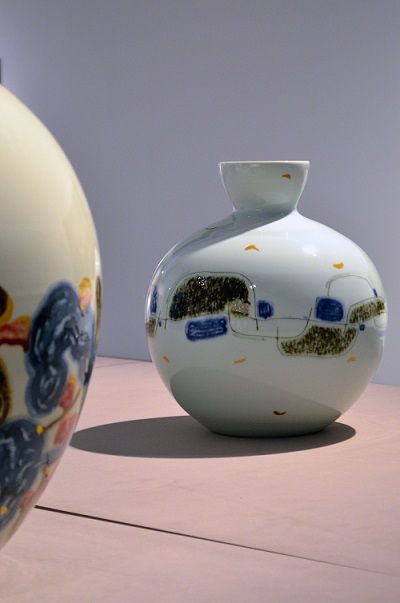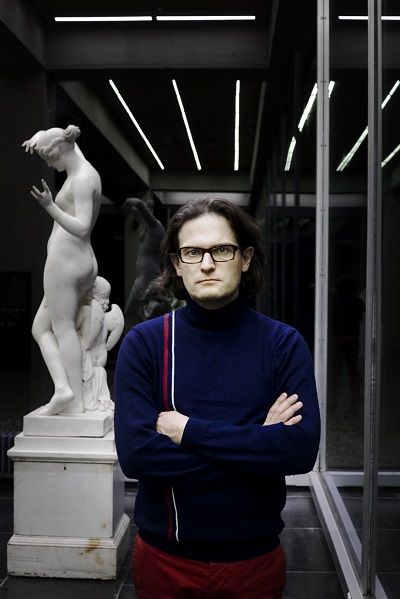
Administrateur-délégué et tête-pensante de Keramis, le centre de la céramique de la Louvière, un musée installé dans l’ancienne faïencerie Boch frères (1841-2011), l’historien de l’art Ludovic Recchia évoque ce médium ancré dans le patrimoine wallon, mais aussi dans le présent.

Lorsqu’on se balade dans votre musée, l’impression est que vous avez voulu créer un espace muséal esthétisant, tout en jouant sur la carte didactique. Expliquez-nous.
L’idée de ce musée était clairement de valoriser la tradition de la faïence traditionnelle locale. Une collection de milliers d’objets acquise dans les années 80 lors de la première faillite de Royal Boch est présentée dans la réserve visitable de Keramis, un édifice classé contenant trois anciens fours à charbon. Nous exposons également une série d’œuvres d’art modernes et contemporaines et nous sommes occupés à constituer une collection d’objets design du XIXe à nos jours. Nous voulons clairement mettre l’accent sur la création contemporaine au travers de nos expositions thématiques. L’une des particularités de Keramis est de ne pas séparer les collections permanentes et temporaires mais de les faire dialoguer. Il n’existe aucune rupture entre nos propres collections que nous montrons selon le principe de la rotation et les expositions que nous organisons au fil du temps. Dans le cadre de l’exposition consacrée à l’artiste chinois Bai Ming, j’ai cherché à établir un contact avec ses œuvres et une sélection de nos pièces issues de notre collection. L’architecture du musée – que je qualifierais de silencieuse malgré la force du geste – facilite cette valorisation de l’objet. L’absence de vitrine renforce le rapport sensible qui peut se créer avec les œuvres exposées.

Le contexte de cette valorisation est également au cœur de votre projet.
L’objectif ultime de Keramis est en effet de valoriser ce pan du patrimoine artistique belge dans le contexte, non pas d’un musée du design, mais bien d’un lieu dédié à l’art contemporain. Même si nous sommes ouverts à toutes les techniques, l’idée est clairement de casser les codes liés à la poterie en s’ouvrant à d’autres formes d’expression comme la peinture. Cette exposition de Bai Ming constitue d’ailleurs une première pour le musée puisque nous présentons ses céramiques, ainsi que ses peintures.
La céramique est un médium en plein essor. Comment expliquez-vous cet engouement ?
Il est à chercher, je pense, du côté de notre société actuelle, en quête de repères. Après des années sous le signe de l’art conceptuel, nous ressentons un besoin de revenir à la matière. La notion de métier est à nouveau centrale. La preuve : l’intérêt croissant du public pour d’autres médiums comme le verre ou la tapisserie, eux aussi, en pleine phase de revalorisation.

Chez Keramis, l’aspect de transmission est également au cœur de votre projet à la fois en tant que conservateur et que curateur de vos expositions.
Au travers des résidences d’artistes et des stages ouverts au public – ceux dédiés aux familles sont d’ailleurs toujours complets –, nous voulons en effet reconnecter les gens avec un métier qui, à la fermeture de la faïencerie, s’est complètement perdu. Notre équipe compte deux céramistes : Claire Lizier et Olivia Mortier, en charge des workshops, mais aussi de l’accompagnement des artistes qui viennent ici en résidence. C’est le cas de la peintre française Françoise Pétrovitch qui, avant de venir à Keramis, n’avait aucune expérience du médium. Le résultat du travail qu’elle a réalisé à la Louvière sera montré lors de l’exposition qu’elle présentera bientôt à la BNF de Paris.
Cette année, Keramis fête ses cinq première années d’existence. Quel bilan dressez-vous du travail accompli jusqu’ici ?
Je suis heureux que le musée soit considéré comme le lieu de référence de la céramique en Belgique. À l’origine, il avait été question de se limiter à la création wallonne, mais nous nous sommes battus pour pouvoir élargir le débat en faisant dialoguer passé et présent, mais aussi artistes locaux, belges et internationaux. Aujourd’hui, mon objectif serait de trouver des financements pour créer de nouvelles expositions, mais aussi d’élargir nos collections et, pourquoi pas, d’agrandir l’atelier pour pouvoir y créer des pièces de plus grande taille dans le cadre de nos collaborations avec des artistes.
